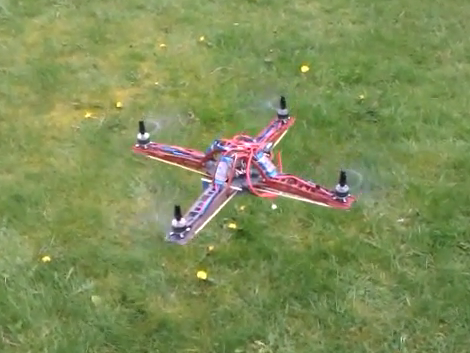
What a sweet thing it is to see the first outdoor flight of a quadcopter. [Botched] has done a wonderful job of documenting the entire build process. Take a look at all that he has done, then jump after the break to see the extremely stable test flight footage.
Earlier iterations used feedback electronics that he designed, etched, and soldered himself. We think they looked pretty good, but he was not happy with the performance. He spent a bunch of time redesigning the IMU board, but after he printed out the PCB artwork he decided his soldering was not up to the QFN challenge and he went with a pre-assembled breakout board.
His post about PID tuning is quite interesting. He removed two of the motors and mounted those opposite ends of the chassis to a hinged stand. This let him tweak the feedback loop until the two remaining propellers were able to maintain balance even when he nudged the unit.
His test flight footage is accompanied by an on-board camera shot. He simply taped a smart phone to the battery and let it roll. Make sure you turn off your speakers before watching this one or the motor noise will let the boss know you’re reading Hackaday again instead of working.
http://www.youtube.com/watch?v=YA5gMKi6e9s
[Thanks Joel]















While the quad might be stable the camera isn’t. Wozers. Could you strap the camera to it or use a tripod next time?
can some one gimme a brief list of parts and procedure to get live feed from the quad ?
Hackaday really needs to have a “No, Seriously, you can solder QFNs just fine” post.
Its incredibly easy with a hot air gun, and if you’re bothering to build your own quadcopter, its probably a tool you’re going to find reason to use many times.
Agree! That would be awsome. I never thought SMD soldering was that easy! But from now on, i only solder SMD because of the saved space. In my first result i was like ‘Hu, i can do this even more smaller’.
But the agenda is to spread out the anti-SMD FUD to sell more breakout boards. Oops, sorry for saying it out loud.